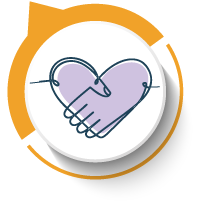Learning Objectives
By the end of this topic, the student should be able to:
- Describe the role of peer-engaged, peer-led, and peer support services in the context of opioid use.
- Describe the emerging evidence for the effectiveness of peer-engaged and peer-led services.
- Identify the scope of interventions where peers can improve outcomes.
Key Concepts
- Peer support assumes a variety of forms and is tailored to the individual and their specific needs, which makes this approach person centred.
- In addition to the power of shared lived experience, peer workers follow competencies, ensuring respectful and consciousness ways of helping.
- Peer engagement and peer-led services and initiatives are not limited to persons with lived experience of drug use; families, supports, and health and social service providers can also engage with one another as peers.
- Research supports positive outcomes of peer-led services, including reduced substance use and relapse, improved relationships with treatment providers, increased treatment retention, and greater treatment satisfaction.
- Peer-engaged and peer-led services establish trust and help clients create positive changes in their substance use journeys.
- With the power of sharing lived experiences, peer support is beneficial to others who either use drugs or are in recovery. Peer recovery support services emphasize respecting diverse paths to recovery and the need for long-term continuing support services through personal, familial, and community resources.
What is Peer Engagement, Peer Support, and Peer-Led Services?
Peer
A peer is defined as a person with equal standing in a community who shares a common lived experience. Peers are therefore experts in their own experience and provide important perspectives.
Peers are not bound by the professional ethical barriers against personal relationships with clients and can help them navigate community resources to seek employment, address criminal justice issues, or attend mutual-help groups.
Peer engagement
Peer engagement uses a community-based approach—community engagement is more likely to reintegrate the individual back into the community and be effective for long-term adherence to stopping opioid use.
Peer support
Peer support can be defined as the process of giving and receiving nonprofessional, nonclinical assistance from individuals with similar conditions or circumstances to aid in the achievement of long-term recovery. Peer support can take the form of support groups, individual counselling, and case management.
Peer-led services
Peer-led services are run with peers as leaders and include such services as peer-led groups and individual peer support.
A client-centred approach includes the engagement of peers who can identify barriers to accessing health services and can discuss the feasibility of treatment options and the affordability of community resources.
The engagement of peers in harm reduction services can help reduce stigma, discrimination, and barriers to access, improve knowledge translation, and build trust.
Peer support has emerged as a highly effective and empowering method to manage the social context of health issues and is particularly popular in the substance abuse and mental health fields.
Peer support workers are people who have been successful in the recovery process and who now help others experiencing similar situations.
- Peer support workers help people become and stay engaged in the recovery process and reduce the likelihood of relapse, possibly because of shared understanding, respect, and mutual empowerment.
- Peer support services can effectively extend the reach of treatment beyond the clinical setting into the everyday environment of those seeking a successful, sustained recovery process.
How Does Peer Support Help?
NOTE: The role of a peer support worker complements, but does not duplicate or replace, the roles of therapists, case managers, and other members of a treatment team.

Peer support workers bring their own personal knowledge of what it is like to live with a substance use disorder.
- Peers support progress towards recovery and self-determined lives by sharing vital lived experience and real examples of recovery.
- The sense of mutuality created through mutual sharing of experience is highly influential in modelling recovery and offering hope.
- Peer-engaged and peer-led services establish trust and help clients create positive changes in their substance use journeys.
Some of the ways documented by research that peer support helps others living with substance use include the following:
- increased self-esteem and confidence
- increased sense of control and ability to bring about changes in their lives
- feelings of empowerment
- increased sense that treatment is responsive to their needs
- increased sense of hope and inspiration
- increased empathy and acceptance (camaraderie)
- increased engagement in self-care and wellness
- increased social support and social functioning
Peer Recovery Support Services
Peer recovery support services (PRSS) are being employed to assist individuals with substance use disorders. Individuals with lived experience can support those currently experiencing SUD and commonly co-occurring mental and social issues, without the lens of stigma or discrimination.
- PRSS facilitate and support clients through different phases of SUD treatment and transitions across different levels of care (e.g., inpatient and outpatient care).
- PRSS recognize there are diverse paths to recovery and that long-term support is needed.
- Long-term support services may be obtained through personal, familial, and community resources.
- Peers can play a key role in harm reduction, including outreach, naloxone distribution, and overdose prevention sites.
Other Types of Peer Programming Around Opioid Use
- Health professionals can engage in their capacity in peer programming.
- For example, physicians may serve as peer assessors for their colleagues to determine their success in following the guidelines for methadone maintenance treatment.
- Peer support can help with substance use during pregnancy.
- For example, one study (Fiddian-Green, 2017) used online storytelling by women with a history of using substance during pregnancy to help provide support for the person using opioids.
- Peer support can be important for the friends and family of the person using opioids.
- For example, peer support is fundamental to programs for family members of persons who are using opioids, who are struggling with opioid use disorder, or who have experienced opioid overdose.
- It can be therapeutic for families to share stories with other families who have experienced or are experiencing a family member using opioids.
Evidence for Efficacy of Peer Involvement

There is a growing literature assessing the role and efficacy of peer-led and peer-involved services for persons who use opioids. Examples include the following:
- Deering et al. (2011) demonstrated that a peer-led mobile outreach program was successful in engaging sex workers in treatment programs.
- Foreman-Mackey et al. (2019) identified peers as one of the factors that contributed to an early unsanctioned overdose prevention site in Toronto.
- Young and Heinzerling (2017) determined that peer support through social media was valuable in improving measures of addiction and overdose in opioid pain clients.
- Krawczyk et al. (2018) identified de-stigmatization as one of the benefits of peer support groups for people starting opioid agonist therapy.
- A systematic review (Eddie et al., 2019) supports several positive findings of peer-led services, including reduced substance use and relapse, improved relationships with treatment providers and social supports, increased treatment retention, and greater treatment satisfaction.
Questions
References
Buxton, J., Stevenson, J., & LaCroix. (2016). The role of peers: BC overdose action exchange meeting. BC Centre for Disease Control. http://www.bccdc.ca/resource-gallery/Documents/Educational%20Materials/Epid/Other/Peer%20primer%20for%20BCOAE.pdf.
Coatsworth-Puspoky, R., Forchuk, C., & Ward‐Griffin, C. (2006). Peer support relationships: An unexplored interpersonal process in mental health. Journal of Psychiatric and Mental Health Nursing, 13(5), 490–497.
Deering, K. N., Kerr, T., Tyndall, M. W., Montaner, J. S., Gibson, K., Irons, L., & Shannon, K. (2011). A peer-led mobile outreach program and increased utilization of detoxification and residential drug treatment among female sex workers who use drugs in a Canadian setting. Drug and Alcohol Dependence, 113, 46–54.
Eddie, D., Hoffman, L., Vilsaint, C., Abry, A., Bergman, B., Hoeppner, B., Weinstein, C., & Kelly, J. F. (2019). Lived experience in new models of care for substance use disorder: a systematic review of peer recovery support services and recovery coaching. Frontiers in Psychology, 10, 1052. https://doi.org/10.3389/fpsyg.2019.01052
Foreman-Mackey, A., Bayoumi, A. M., Miskovic, M., Kolla, G., & Strike, C. (2019). “It's our safe sanctuary”: Experiences of using an unsanctioned overdose prevention site in Toronto, Ontario. International Journal of Drug Policy, 73, 135–140.
Kelly, J. F., Fallah-Sohy, N., Cristello, J., & Bergman, B. (2017). Coping with the enduring unpredictability of opioid addiction: An investigation of a novel family-focused peer-support organization. Journal of Substance Abuse Treatment, 77, 193–200.
Krawczyk, N., Negron, T., Nieto, M., Agus, D., & Fingerhood, M. I. (2018). Overcoming medication stigma in peer recovery: A new paradigm. Substance Abuse, 9, 404–409.
Mental Health Commission of Canada. (n.d.). Peer support. https://www.mentalhealthcommission.ca/English/what-we-do/recovery/peer-support
Paterno, M. T., Low, M., Gubrium, A., & Sanger, K. (2018). Mothers and mentors: Exploring perinatal addiction and recovery through digital storytelling. Qualitative Health Research, 1, Article 1049732318777474.
Strike, C., Wenghofer, E., Gnam, W., Hillier, W., Veldhuizen, S., & Millson, M. (2007). Physician peer assessments for compliance with methadone maintenance treatment guidelines. Journal of Continuing Education in the Health Professions, 27, 208–213.
Substance Abuse and Mental Health Services Administration. (2020). Core competencies for peer workers. U.S. Department of Health & Human Services. https://www.samhsa.gov/brss-tacs/recovery-support-tools/peers/core-competencies-peer-workers
Taha, S. (2018). Best practices across the continuum of care for treatment of opioid use disorder. Canadian Centre on Substance Use and Addiction. https://www.ccsa.ca/sites/default/files/2019-04/CCSA-Best-Practices-Treatment-Opioid-Use-Disorder-2018-en.pdf
Ti, L., Tzemis, D., & Buxton, J. A. (2012). Peer engagement in the context of policy and program development: A review of the literature. Substance Abuse Treatment, Prevention, and Policy, 7, Article 47. http://www.substanceabusepolicy.com/content/7/1/47
Young, S., Williams, S., Otterstatter, M., Lee, J., & Buxton, J. (2019). Lessons learned from ramping up a Canadian take home naloxone programme during a public health emergency: A mixed-methods study. Non-analgesic effects of opioids: opioid-induced respiratory depression. Substance Abuse Treatment, Prevention, and Policy, 14, Article 32.
Young, S. D., & Heinzerling, K. (2017). The Harnessing Online Peer Education (HOPE) intervention for reducing prescription drug abuse: A qualitative study. Journal of Substance Use, 22, 592–596.